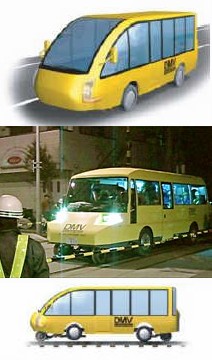
For decades, scientists have explored the possibility of using space-based solar cells to power the Earth. Some see orbiting power stations as a clean and stable energy source that promises to slow global warming, while others dismiss the idea as an expensive and impractical solution to the world's energy problems. While the discussion goes on, researchers at the Japan Aerospace Exploration Agency (JAXA) have begun to develop the hardware.
JAXA, which plans to have a Space Solar Power System (SSPS) up and running by 2030, envisions a system consisting of giant solar collectors in geostationary orbit 36,000 kilometers above the Earth?s surface. The satellites convert sunlight into powerful microwave (or laser) beams that are aimed at receiving stations on Earth, where they are converted into electricity.
On February 20, JAXA will take a step closer to the goal when they begin testing a microwave power transmission system designed to beam the power from the satellites to Earth. In a series of experiments to be conducted at the Taiki Multi-Purpose Aerospace Park in Hokkaido, the researchers will use a 2.4-meter-diameter transmission antenna to send a microwave beam over 50 meters to a rectenna (rectifying antenna) that converts the microwave energy into electricity and powers a household heater. The researchers expect these initial tests to provide valuable engineering data that will pave the way for JAXA to build larger, more powerful systems.
 JAXA says the orbiting solar arrays, which have the advantage of being able to collect energy around the clock regardless of the weather on the ground, will need to transmit microwaves through the earth's atmosphere at frequencies that are not affected by the weather. The researchers are now looking at using the 2.45GHz and 5.8GHz bands, which have been allocated for use with industrial, scientific and medical devices.
JAXA says the orbiting solar arrays, which have the advantage of being able to collect energy around the clock regardless of the weather on the ground, will need to transmit microwaves through the earth's atmosphere at frequencies that are not affected by the weather. The researchers are now looking at using the 2.45GHz and 5.8GHz bands, which have been allocated for use with industrial, scientific and medical devices.
JAXA ultimately aims to build ground receiving stations that measure about 3 kilometers across and that can produce 1 gigawatt (1 million kilowatts) of electricity -- enough to power approximately 500,000 homes.
[Source: Hokkaido Shimbun]












 Researchers from Hokkaido University have created artificial blood vessels using collagen derived from the skin of salmon. The researchers, who replaced the aortas of rats with the artificial blood vessels, claim to be the first to create and successfully test artificial blood vessels made using collagen derived from marine animals.
Researchers from Hokkaido University have created artificial blood vessels using collagen derived from the skin of salmon. The researchers, who replaced the aortas of rats with the artificial blood vessels, claim to be the first to create and successfully test artificial blood vessels made using collagen derived from marine animals.  A dual-mode vehicle (DMV) that looks like a minibus and runs both on conventional railway tracks and paved roads was tested on the Gakunan railway in Fuji city (Shizuoka prefecture) on the night of November 24. The 28-passenger test vehicle was developed by the Hokkaido Railway Company (JR Hokkaido) in a
A dual-mode vehicle (DMV) that looks like a minibus and runs both on conventional railway tracks and paved roads was tested on the Gakunan railway in Fuji city (Shizuoka prefecture) on the night of November 24. The 28-passenger test vehicle was developed by the Hokkaido Railway Company (JR Hokkaido) in a  In squid-crazy Hakodate, squid fishing is big business, the local specialties include shio ramen (squid-topped ramen) and ikasomen (raw squid cut into the shape of somen noodles), the summer festivals have residents busting squid-like moves in a dance called ika-odori (a squirmy version of the traditional bon dance performed at summer festivals throughout Japan), and the city fish is the squid. It is therefore unlikely that anyone was surprised when, on July 18, a group of Hakodate residents made an official announcement regarding plans to create a giant robotic squid for the city.
In squid-crazy Hakodate, squid fishing is big business, the local specialties include shio ramen (squid-topped ramen) and ikasomen (raw squid cut into the shape of somen noodles), the summer festivals have residents busting squid-like moves in a dance called ika-odori (a squirmy version of the traditional bon dance performed at summer festivals throughout Japan), and the city fish is the squid. It is therefore unlikely that anyone was surprised when, on July 18, a group of Hakodate residents made an official announcement regarding plans to create a giant robotic squid for the city.